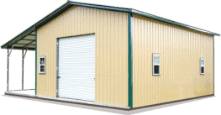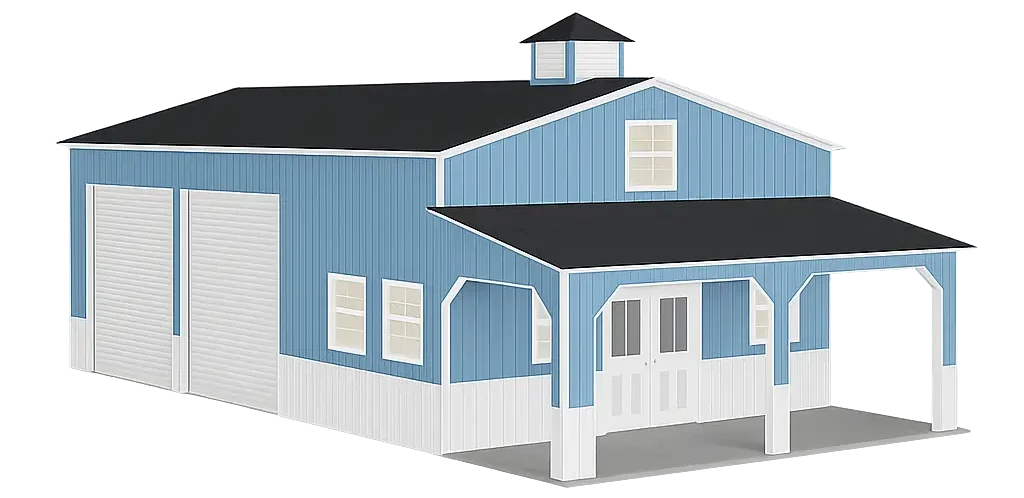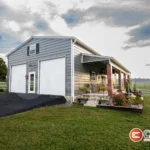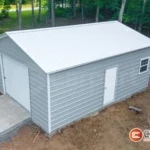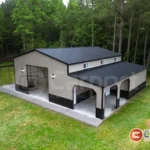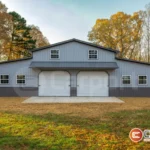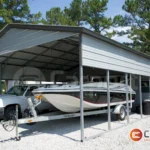25
Pole Barns vs. Red Iron Buildings vs. Prefab Steel Structures: Which Is the Best Building Solution for You?
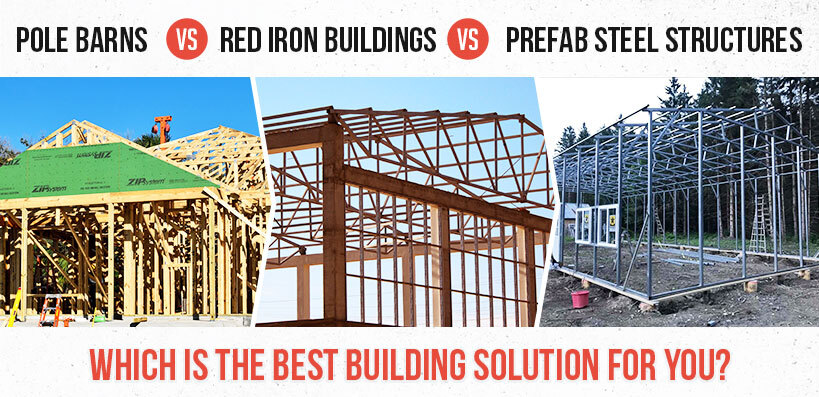
Looking for a reliable building, shelter, or structure for a particular residential, agricultural, commercial, or industrial application? What’s the best framing approach to go with – pole barns, a red iron building, or a steel tube-framed structure? There are many factors to consider and questions you should ask when making the best building choice for your situation; here’s just a short list:
- Materials – Which construction materials are really the strongest and most reliable? Which are the easiest to work with? And which are best suited for the particular intended purposes of your building?
- Dimensions & Design – How big of a building do you need? What specialized functionality, versatility, and adaptability features would you like to see included with your building? Will this building include finished residential space, enclosed storage, open-air storage, workshop space, production space, office space, retail space, vehicle shelter, animal shelter, some combination of the above … or something else? In other words, how do you plan to use your building?
- Cost – Obviously, the initial building manufacturing & installation cost is an important consideration for most individuals, families, and businesses. But initial cost isn’t the only cost to consider; what will be your building’s lifetime cost, as well? It’s important to also factor in what it will cost to keep your building in good working condition over time, too.
- Maintenance & Longevity – Speaking of lifetime ROI, how long do you want or need your building to last? And how much time and effort are you willing (or able) to put into building maintenance?
- Construction/Installation Lead Time – How quickly do you want or need your building to be completed? Manufacturing, construction, and assembly lead times can vary greatly, depending upon the building approach you decide to go with. Some types of building framing and design lend themselves to MUCH faster installation than others, and with less required labor, too.
The Three Building Material/Design Contenders: Pole Barns, Red Iron Buildings, & Steel Tube-Framed Structures
Three of the most common approaches to outdoor structures – and to buildings of all types, for that matter – are pole barns / stick builds, red iron buildings, and prefab metal buildings framed with steel tubing. Here’s a quick overview of each:
Pole Barns / Stick Builds
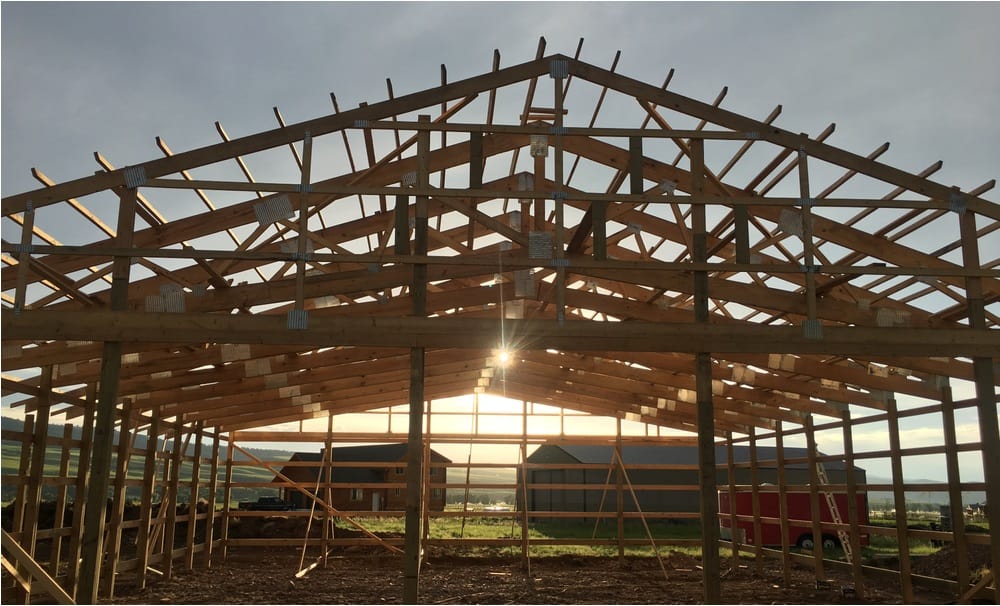
A pole barn is a traditional type of post-frame construction which relies upon large wooden poles or posts buried in the ground to provide the needed vertical structural support. The pole barn method was developed during the 1930s, during a time period when there was a demand for agricultural buildings of larger size dimensions for corporate farms. Pole barn construction was a fairly quick, economical way to add outbuildings for bigger barn and storage areas, and relied heavily upon the use of recycled telephone poles.
A stick build, on the other hand, essentially describes any type of building constructed with wooden stud framing. Stick builds have been a traditional staple of home construction for many generations. As the name suggests, a stick-built home is a wood-framed house which is constructed on site, piece-by-piece, and board-by-board (or stick-by-stick, to use the wooden vernacular). There’s a common perception that stick-built homes and buildings are better constructed, last longer, and demonstrate a better resale value. As it turns out, these perceptions are largely misconceptions. Builders which follow prefabricated methods have been able to demonstrate that a prefab manufacturing approach actually delivers several distinct advantages over manufacturing and building everything on site.
Red Iron Buildings
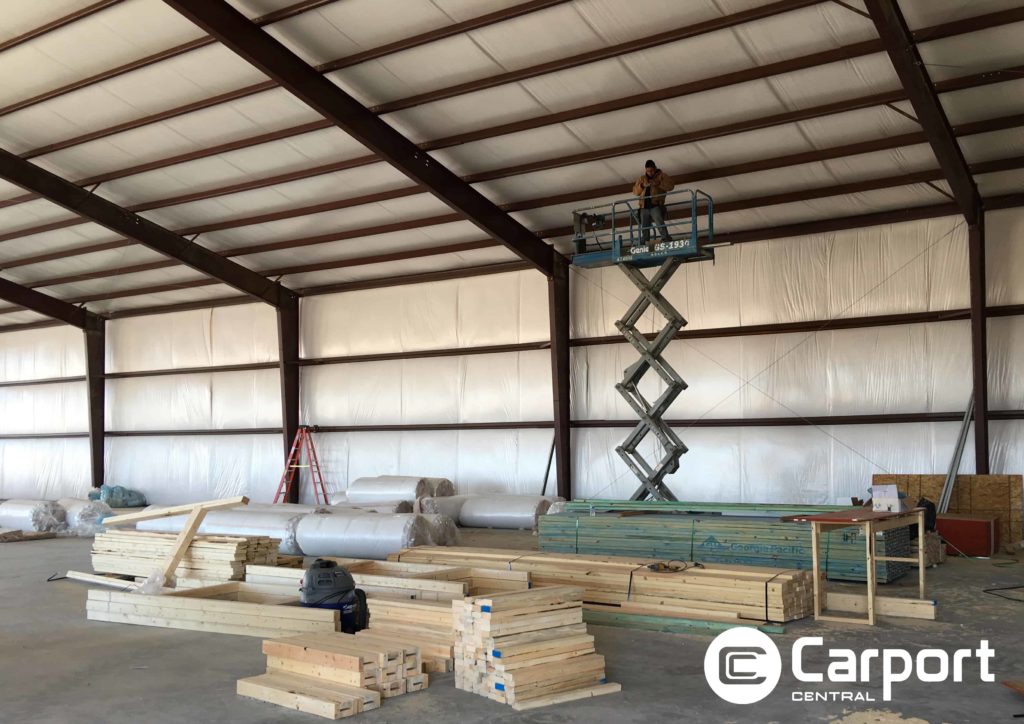
Red iron buildings have been a popular choice for commercial construction around the world for decades. “Red iron” itself is a bit of a misnomer – these frame members are made from solid steel. Because the beams are typically shaped like a capital “I,” these structures are also known as I-beam buildings. The label “red iron” became associated with those buildings because manufacturers applied a light red oxide coating to the fabricated building members to help prevent rust formation during shipping. This red-oxide coating actually evaporates over time, and isn’t meant to prevent long-term rusting.
Red iron buildings are built with heavy steel beams, which allow for clear-span construction. In other words, the beams themselves support the building’s weight and manage the loads, such that interior columns aren’t needed. What that translates to, is plenty of usable clear-span interior space. A red iron building must be installed on either a concrete slab or a series of concrete footers, and it also offers unlimited width, length, and height options. Red iron buildings are also well-suited for structures which are designed to include multiple stories and mezzanine levels. They have a reputation of being strong buildings, and they require much less maintenance than comparable wood-framed buildings.
Prefab Steel Structures

While red iron buildings also have components which are technically prefabricated, a prefab metal building or prefab steel structure refers to a building constructed with cold-formed, prefabricated steel tube framing. In this building approach, galvanized sheet steel is roll-formed into all sorts of building components, including everything from studs, to joists and headers, to channels, along with various forms of steel paneling, roofing, and trim. These steel components can be formed into specified thicknesses or gauges in order to meet a wide range of structural needs and requirements. Cold-formed steel tubing is much lighter than solid steel, while still reaching an incredibly high strength-to-weight ratio. Through this cold-formed steel tube method, much less material is needed to frame a building than is required with red iron, pole barn, or stick-built approaches to construction. Prefab steel barns also need less labor to install, and are more versatile in terms of their variety of potential building applications.
Metal Buildings vs. Pole Barns / Wood Buildings
Both red iron buildings and prefab steel structures have some distinct advantages over construction with wood. We’ve detailed the many advantages of metal construction over wood construction in past blogs (like this one and this one), so we won’t belabor that point here. Here’s just a quick summary of some of the reasons why steel is better suited for construction applications than wood:
• Stronger
There’s not a better commercially-available building material than steel in terms of sheer strength. Steel members can support greater loads and offer more efficient usage of materials than building with wood.
• More dimensionally stable
Unlike wood, steel doesn’t expand or contract due to moisture influences. Once the steel member is measured and fabricated, you won’t have to worry about its dimensions changing over time. Steel doesn’t split or warp like wood, either. With steel, you won’t ever have to be concerned about the crack formation, nail heads popping out, or related problems that come along with wood construction.
• Pest-resistant and rot-proof
Termites, mold, and mildew are natural enemies of wood, but they pose no threat to steel. Pests like rodents can’t really make a dent in steel, either. Steel is essentially pest-proof and rot-proof.
• Non-combustible
If you’ve ever built or been around a campfire, you know that wood burns. Pole barns and wood-framed structures will burn, too. Steel, on the other hand, is a non-combustible material. While non-combustible doesn’t necessarily equate to fire-proof (even steel will melt with enough heat), a steel structure is certainly much more fire-resistant than any wooden structure.
• Cost to build
Many assume that it will be cheaper to build with wood, but that usually isn’t the case. In fact, the larger the building, the cheaper it is to build with steel. Combine that with the fact that lumber prices have absolutely skyrocketed over the past year, and you’ll see that the price tag for a steel structure is much cheaper than you might have realized!
• Low-maintenance
Wood used in construction will require ongoing treatment, pest prevention, and maintenance for the life of the structure, especially if you have any wood exterior features. Steel construction materials, on the other hand, never need refinishing, and they’re much more resilient than any wooden construction members. In terms of basic ongoing maintenance costs and efforts, steel is a much more attractive option.
• 100% recyclable
While wood can sometimes be “reclaimed” and reused for certain applications, wood is not recyclable by definition. Steel, however, is an endlessly recyclable material, with no degradation of structural properties. Beyond this, the steel building components used in modern construction themselves contain a minimum of 25% recycled content. If conserving and reducing your ecological footprint is important to you, then you really can’t choose a better construction material than steel.
• Much longer lead time for stick builds
If speed of construction matters to you, then you should know that custom wood buildings require the longest lead time for construction and assembly. Once construction starts, a basic pole barn can be built in around three weeks (larger barns take longer). But that doesn’t count the lead time between when you place your order and when onsite construction actually begins. The amount of time it takes for a pole building to be built after you sign a contract depends on how far out the contractor is scheduling, material availability, and other factors. This can vary widely, but it will certainly add more lead time to your project. And stick builds for home or commercial construction take much longer than that – it’s not just a matter of weeks, it’s usually a matter of many MONTHS. Prefabricated metal buildings, on the other hand, go up considerably quicker. All material components arrive from the manufacturing facility pre-cut and pre-measured, so assembly is a much simpler and faster process than onsite construction with wood.
Red Iron Buildings vs. Prefab Steel Structures
Now that we’ve established that metal buildings are superior to pole barns and stick builds, it’s time to decide which metal building approach is best – red iron, or prefab steel tubing. We’ll start by looking a little closer at red iron, since it’s been around longer.
Traditional Red Iron Buildings Are Good…
“Red iron” pre-engineered metal buildings started gaining popularity in the 1950s, and are still a standard choice for a large percentage of general contractors. Red iron buildings are best suited for large commercial facilities or for applications that require a lot of wide-open storage space. Red iron buildings are certainly sturdy, but they’re also bulky and heavy, and require special equipment to be able to install. Sadly, there hasn’t been much in the way of innovation since red iron building design was first introduced many decades ago. They are typically engineered to meet minimum local building codes, but no more. The heavy I-beam posts also require large footers or a special foundation design. The tapered columns are usually situated 20’ on center; with this much spacing between columns, additional stud framing is needed for interior finishing. The tapered nature of the columns also ends up taking away some of a red iron building’s usable interior space.
…But Prefab Steel Tube-Framed Structures Are Better!
• Design
Pre-engineered steel tubing structures have some clear design advantages over red iron buildings. Rather than relying on heavy I-beams for support, modern prefab metal buildings (or PMBs) are framed with steel tubing cold-formed from galvanized steel sheets. This tubing is engineered in a way that requires much less material and is much more lightweight, while still delivering impressive strength and load capacity. In most cases, a PMB can actually be designed to be able to support greater loads than a red iron building can.
For example, the industrial-framed buildings sourced by Carport Central don’t just meet minimum local codes, they actually exceed most every state and local code by default! In addition, many custom metal building manufacturers allow for framing columns to be placed 4’ on center, meaning these buildings are ready-made for interior finishing. Carport Central’s exclusive frame design allows for quicker, easier electrical and plumbing installation, too. And here’s one more design advantage – these PMBs don’t require large footers, and in fact, don’t require any special poured foundation at all. These buildings can be anchored to practically any type of site surface, including concrete, asphalt, gravel, even plain level ground!
• Lead Time
How fast do you need your building? If you choose red iron, you’ll certainly have to wait longer. Once you sign the contract for a red iron building, the typical lead time for delivery of materials to your site takes around 10 weeks. The installation will then take another 4-8 weeks, depending upon the nature of your particular structure. Taken together, the total lead time for a red iron building can run from 14 to 18 weeks – in other words, around four months.
You can get an industrial frame PMB from Carport Central much faster. During normal conditions (with no weather or supply issues), Carport Central can get your building delivered and installed in just 3-4 weeks! That’s three months faster than a red iron building!
• Cost
Some people are willing to wait longer for a red iron building based purely on the perception that they’ll save some money by going with red iron. It’s understandable why folks would think that, since the initial contract price for a red iron building is usually less than that for a comparable industrial frame PMB. However, it’s critically important to understand what each contract actually includes! Most red iron building contracts only provide for the fabrication and delivery of materials, and not installation. In fact, most red iron manufacturers don’t even offer installation services at all. You’ll have to find an outside contractor to put up your building for you, and that additional cost and effort on your part can end up being quite substantial, as red iron building construction is a labor-intensive process.
While an industrial frame PMB from Carport Central may appear to cost a little more at the outset, it’s really a cheaper option in the end. Why? Our buildings come with delivery and installation included, and we install almost anywhere within the entire continental United States! Remember that our buildings don’t come with any special foundation design requirements, either. If you don’t want to have to spend the extra money to pour large footers and/or pave a hard foundation for our building, you don’t have to!
Carport Central Can Deliver & Install Your Perfect Custom Steel Structure!
Ready to get your own perfect custom steel building installed for residential, commercial, agricultural, or even industrial purposes? Carport Central has you covered! We do A LOT more than just metal carports; we also provide everything from garages to barns to sheds to utility buildings, along with retail storefronts, auto service centers, warehouses, manufacturing facilities, and even metal building homes that are ready to be finished. Want to try your hand at creating your own personalized building design? Take advantage of our signature easy-to-use 3D Building Designer on any computer or smart device. You can save your favorite design, and even use it to get your building order started!
Prefer to speak with a real, live human? Our friendly building specialists are trained, knowledgeable, and ready to help! Just give us a call at (980) 321-9898 and experience the Carport Central difference for yourself.
Get Started
It's fast and easy. Get your instant quote today!
BLOG TOPICS
- Certified Carports (2)
- COVID-19 (1)
- Prefab Metal Buildings (66)
- Metal Building Homes (6)
- Metal Building of the Week (11)
- Install of the week (1)
- Metal Building Extensions (1)
- Install of the month (2)
- Garages (52)
- Farm Show (1)
- Building Components (1)
- Carports (29)
- Storage Sheds (15)
- Metal Buildings (6)
- Barns (18)
- Metal Homes (8)
- Metal Sheds (1)
- RV Covers (6)
- 12 Gauge Framing (7)
- Workshops (7)
- Eagles & Buildings (1)
- Reviews (2)
- Snowfall in the Southeast (2)
- Carports and Buildings Prices (1)
- Reality Of Discounted Buildings (2)
- Snow Removal (1)
- Offers (3)
- Condensation in Metal Buildings (2)
- News & Awards (12)
- Livestock sheds (4)
- Installations (15)
- Metal Buildings Applications (7)
- Customized Buildings (41)
- Carport Sizes (2)
- Facts (1)
Metal Buildings
- Alabama
- Arizona
- Arkansas
- California
- Colorado
- Connecticut
- Delaware
- Florida
- Georgia
- Idaho
- Illinois
- Indiana
- Iowa
- Kansas
- Louisiana
- Maine
- Maryland
- Massachusetts
- Michigan
- Minnesota
- Mississippi
- Missouri
- Montana
- Nebraska
- Nevada
- New Hampshire
- New Jersey
- New Mexico
- New York
- North Carolina
- North Dakota
- Ohio
- Oklahoma
- Oregon
- Pennsylvania
- Rhode Island
- South Carolina
- South Dakota
- Tennessee
- Texas
- Utah
- Vermont
- Virginia
- Washington
- West Virginia
- Wisconsin
- Wyoming
Metal Garages
- Alabama
- Arizona
- Arkansas
- California
- Colorado
- Connecticut
- Delaware
- Florida
- Georgia
- Idaho
- Illinois
- Indiana
- Iowa
- Kansas
- Louisiana
- Maine
- Maryland
- Massachusetts
- Michigan
- Minnesota
- Mississippi
- Missouri
- Montana
- Nebraska
- Nevada
- New Hampshire
- New Jersey
- New Mexico
- New York
- North Carolina
- North Dakota
- Ohio
- Oklahoma
- Oregon
- Pennsylvania
- Rhode Island
- South Carolina
- South Dakota
- Tennessee
- Texas
- Utah
- Vermont
- Virginia
- Washington
- West Virginia
- Wisconsin
- Wyoming
Metal Carports
- Alabama
- Arizona
- Arkansas
- California
- Colorado
- Connecticut
- Delaware
- Florida
- Georgia
- Idaho
- Illinois
- Indiana
- Iowa
- Kansas
- Louisiana
- Maine
- Maryland
- Massachusetts
- Michigan
- Minnesota
- Mississippi
- Missouri
- Montana
- Nebraska
- Nevada
- New Hampshire
- New Jersey
- New Mexico
- New York
- North Carolina
- North Dakota
- Ohio
- Oklahoma
- Oregon
- Pennsylvania
- Rhode Island
- South Carolina
- South Dakota
- Tennessee
- Texas
- Utah
- Vermont
- Virginia
- Washington
- West Virginia
- Wisconsin
- Wyoming
- 100x100 Metal Building
- 12x12 Metal Shed
- 12x20 Carport
- 12x24 Carport
- 12x30 Carport
- 16x20 Carport
- 18x20 Carport
- 20x20 Carport
- 20x20 Metal Building
- 20x30 Carport
- 20x30 Metal Building
- 20x40 Carport
- 20x40 Metal Building
- 24x24 Carport
- 24x24 Garage
- 24x30 Carport
- 24x30 Metal Building
- 24x30 Metal Garage
- 24x36 Metal Building
- 26x30 Metal Building
- 30x30 Carport
- 30x30 Garage
- 30x30 Metal Building
- 30x40 Carport
- 30x40 Garage
- 30x40 Metal Building
- 30x40 Storage Building
- 30x50 Metal Building
- 30x60 Metal Building
- 40x100 Metal Building
- 40x40 Metal Building
- 40x60 Metal Building
- 40x80 Metal Building
- 50x100 Metal Building
- 50x50 Metal Building
- 50x80 Metal Building
- 60x100 Metal Building
- 60x120 Steel Building
- 60x60 Metal Building
- 60x80 Metal Building
- 80x100 Metal Building
- All Steel Carports
- American Building Network
- American Custom Carports
- American Steel Carports
- Arkansas Carports
- Best Choice Metal Structures
- California All Steel
- Carports Outlet
- Central Texas Metal Buildings
- Coast To Coast Carports
- Custom Steel Structures
- Dreams Carports and Buildings Inc
- East Coast Carports
- Enterprise Steel Structures
- Infinity Carports
- Interstate Steel Structures
- Long Horn Buildings
- Midwest Steel Carports
- NC Structures
- New Team Carports
- Northside Metal Carports
- Quality Carports
- Rhino Carports
- Safeguard Metal Buildings
- Southern Steel Buildings Inc.
- Steel Buildings and Structures
- Tennessee Steel Buildings
- Tubular Building Systems
- Ultimate Metal Buildings
- United Structures
- USA Carports







